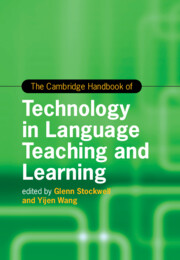Refine search
Actions for selected content:
31 results
On the nascency of ChatGPT in foreign language teaching and learning
-
- Journal:
- Annual Review of Applied Linguistics / Volume 45 / March 2025
- Published online by Cambridge University Press:
- 08 August 2025, pp. 148-178
-
- Article
-
- You have access
- Open access
- HTML
- Export citation

Generative Artificial Intelligence and Language Teaching
-
- Published online:
- 26 June 2025
- Print publication:
- 24 July 2025
-
- Element
- Export citation

The Cambridge Handbook of Technology in Language Teaching and Learning
-
- Published online:
- 15 June 2025
- Print publication:
- 26 June 2025
From revolution to evolution: What generative AI really means for language learning
-
- Journal:
- Language Teaching , First View
- Published online by Cambridge University Press:
- 14 May 2025, pp. 1-17
-
- Article
-
- You have access
- Open access
- HTML
- Export citation

Teaching Second Language Academic Writing
-
- Published online:
- 20 February 2025
- Print publication:
- 20 February 2025
-
- Element
- Export citation
Chapter 4 - Immigrant community languages and additional languages
- from Part 2 - Who speaks what?
-
- Book:
- Teaching for Linguistic Diversity in Schools
- Published online:
- 25 October 2024
- Print publication:
- 27 June 2024, pp 67-87
-
- Chapter
- Export citation

Input
-
- Published online:
- 28 May 2024
- Print publication:
- 27 June 2024
-
- Element
- Export citation
9 - Mastering Connectives in a Second Language
-
- Book:
- Connectives and Discourse Relations
- Published online:
- 22 February 2024
- Print publication:
- 29 February 2024, pp 188-208
-
- Chapter
-
- You have access
- Open access
- HTML
- Export citation

Phonetics in Language Teaching
-
- Published online:
- 19 December 2022
- Print publication:
- 19 January 2023
-
- Element
- Export citation
28 - Pragmatic Competence
- from Part V - Language Learning
-
-
- Book:
- The Cambridge Handbook of Intercultural Pragmatics
- Published online:
- 29 September 2022
- Print publication:
- 20 October 2022, pp 741-765
-
- Chapter
- Export citation
23 - Feeling at Home across Languages, Schools and Countries
-
-
- Book:
- Multilingualism and Education
- Published online:
- 02 June 2022
- Print publication:
- 09 June 2022, pp 194-201
-
- Chapter
- Export citation

Reflective Practice in Language Teaching
-
- Published online:
- 22 April 2022
- Print publication:
- 19 May 2022
-
- Element
- Export citation

Technology and Language Teaching
-
- Published online:
- 31 March 2022
- Print publication:
- 28 April 2022
-
- Element
- Export citation

Intercultural and Transcultural Awareness in Language Teaching
-
- Published online:
- 10 March 2022
- Print publication:
- 07 April 2022
-
- Element
- Export citation

Mobile Assisted Language Learning
- Concepts, Contexts and Challenges
-
- Published online:
- 23 December 2021
- Print publication:
- 06 January 2022
8 - Heritage Languages in Canada
- from Part I - Heritage Languages around the World
-
-
- Book:
- The Cambridge Handbook of Heritage Languages and Linguistics
- Published online:
- 04 November 2021
- Print publication:
- 25 November 2021, pp 178-204
-
- Chapter
- Export citation
9 - In Learner Language and Language Teaching
-
- Book:
- General Extenders
- Published online:
- 20 August 2021
- Print publication:
- 02 September 2021, pp 177-197
-
- Chapter
- Export citation
Introduction
-
- Book:
- The Invention of Multilingualism
- Published online:
- 04 June 2021
- Print publication:
- 17 June 2021, pp 1-42
-
- Chapter
- Export citation

Revitalizing Endangered Languages
- A Practical Guide
-
- Published online:
- 22 April 2021
- Print publication:
- 29 April 2021
-
- Book
-
- You have access
- Open access
- Export citation
5 - Language Education
-
- Book:
- Grammar
- Published online:
- 10 September 2020
- Print publication:
- 01 October 2020, pp 161-191
-
- Chapter
- Export citation
